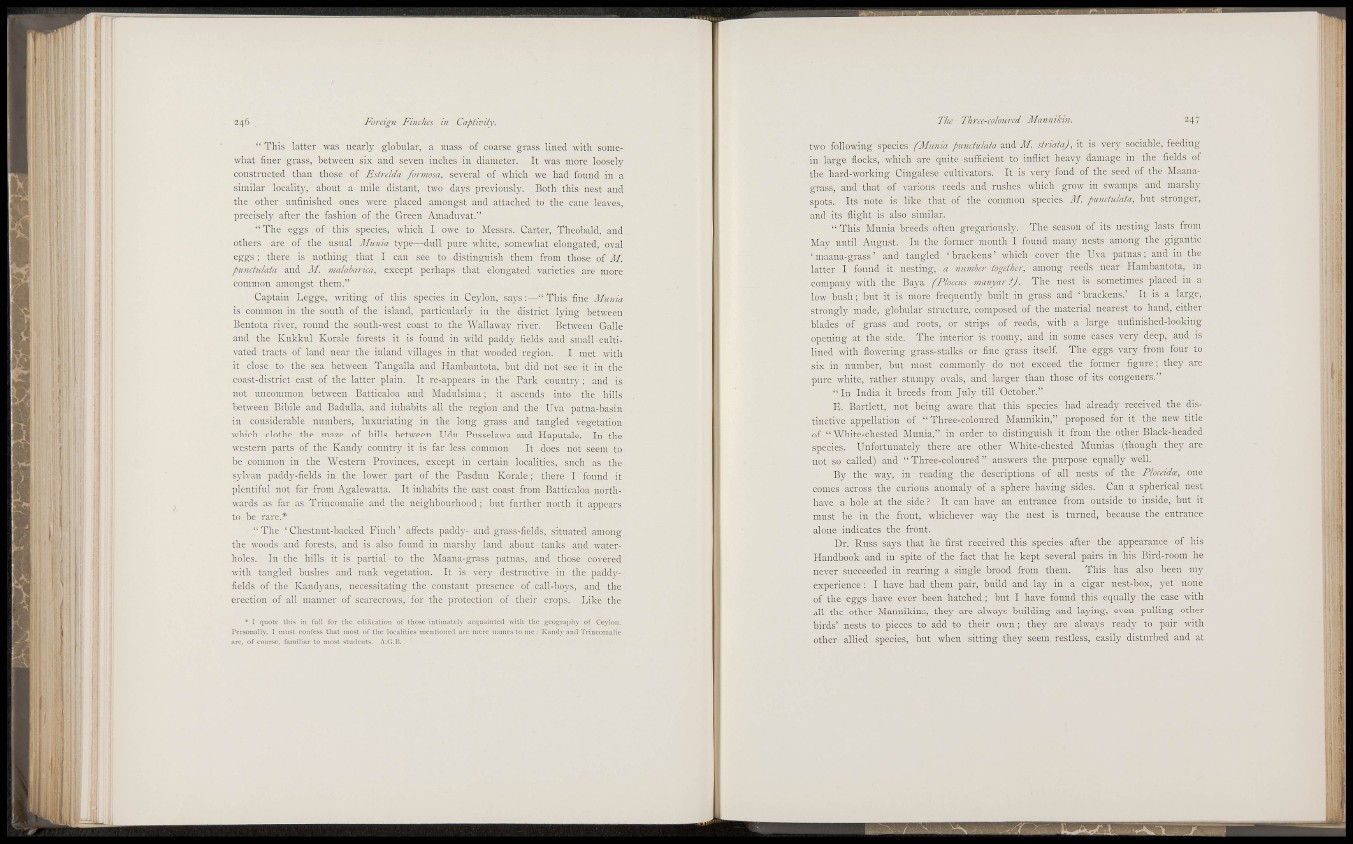
li iNm•m
W.
246 Foreign Finches in Caplivity.
" This latter was iiearl}^ globular, a mass of coarse grass lined with somewhat
finer grass, between six and seven inches in diameter. It was more looselj'
constructed than those of Estrdda formosa, several of which we had found in a
similar locality, about a mile distant, two days previously. Both this nest and
the other unfinished ones were placed amongst and attached to the cane lea\-es,
precisely after the fashion of the Green Amaduvat."
" The eggs of this species, which I owe to Messrs. Carter, Theobald, and
others are of the usual Alunia type—dull pure white, somewhat elongated, oval
eggs ; there is nothing that I can see to distinguish them from those of M.
punctulata and ]\I. malabarica, except perhaps that elongated varieties are more
common amongst them."
Captain Legge, writing of this species in Ceylon, saj-s :—" This fine Miinia
is common in the south of the island, particularly in the district lying between
Bentota ri^-er, round the south-west coast to the AVallaway river. Between Galle
and the Kukkul Korale forests it is found in wild paddy fields and snuill cultivated
tracts of laud near the inland villages in that wooded region. I met with
it close to the sea between Tangalla and Hambantota, but did not see it in the
coast-district east of the latter plain. It re-appears in the Park countr}- ; and is
not nncomnion between Batticaloa and Madulsima; it ascends into the hills
between Bibile and Badulla, and inhabits all the region and the Uva patna-basin
in considerable numbers, luxuriating in the long grass and tangled vegetation
which clothe the maze of hills between Udu Pusselawa and Haputale. In the
western parts of the Kandy countrj' it is far less common It does not seem to
be common in the Western Provinces, except in certain localities, snch as the
S)-lvan paddy-fields in the lower part of the Pasdun Korale; there I found it
plentiful not far from Agalewatta. It inhabits the east coast from Batticaloa northwards
as far as Trincomalie and the neighbourhood ; but further north it appears
to be rare.*
The ' Chestnut-backed Finch ' affects paddj-- and grass-fields, situated among
the woods and forests, and is also found in marslw land about tanks and waterholes.
In the hills it is partial to the Maana-grass patnas, and those covered
with tangled bushes and rank vegetation. It is very destructive in the paddyfields
of the Kand3-ans, necessitating the constant presence of call-boys, and the
erection of all manner of scarecrows, for the protection of their crops. Like the
* I quote this in full for the edificatiou of those intimately acf|iiaintcd "with the ^eo^rapiiy of Ccyloii.
Personally. I must confe-ss that most of the localities mentioned are mere names to me : Kandy and Trincomalie
are, of course, fanjiliar to most students, .-\,G.B,
The Thrcc-cohurcd Mannikin. 247
two following species (Munia piinctn/ata and M. striataj, it is very sociable, feeding
in large flocks, which are quite sufficient to inflict heavy damage in the fields of
the hard-working Cingalese cultivators. It is very fond of the seed of the Maanagrass,
and that of ^'arious reeds and rushes which grow in swamps and marshy
spots. Its note is like that of the common species M. piaiclulata, but .stronger,
and its flight is also similar.
" This Munia breeds often gregariously. The season of its nesting lasts from
May until August. In the former month I found many nests among the gigantic
' maana-grass' and tangled ' b rackens' which cover the Uva patnas; and in the
latter I found it nesting, a number together, among reeds near Hambantota, in
company with the Baya fPloccus manyar ?J. The nest is sometimes placed in a
low bush ; but it is more frecptently built in grass and ' brackens.' It is a large,
strongly made, globular structure, composed of the material nearest to hand, either
blades of grass and roots, or strips of reeds, with a large unfinished-looking
opening at the side. The interior is roomy, and in some cases very deep, and is
lined with flowering grass-stalks or fine grass itself. The eggs vary from four to
six in number, but most commonly do not exceed the former figure; they are
pure white, rather stumpy ovals, and larger than those of its congeners."
" I n India it breeds from July till October."
E. Bartlett, not being aware that this species had already received the distinctive
appellation of "Three-coloured Mannikin," proposed for it the new title
of "White-chested Munia," in order to distinguish it from the other Black-headed
species. Unfortunately there are other White-chested Munias (though they are
not so called) and "Three-coloured" answers the purpose equally well.
By the way, in reading the descriptions of all nests of the Ploceidm, one
comes across the curious anomaly of a sphere having sides. Can a spherical nest
have a hole at the side? It can have an entrance from outside to inside, but it
must be in the front, whichever way the nest is turned, because the entrance
alone indicates the front.
Dr. Russ says that he first received this species after the appearance of his
Handbook and in spite of the fact that he kept several pairs in his Bird-room he
never succeeded in rearing a single brood from them. This has also been my
experience : I have had them pair, build and lay in a cigar nest-box, yet none
of the eggs have ever been hatched; but I have found this equally the case with
all the other Mannikins, they are always building and laying, even pulling other
birds' nests to pieces to add to their own; they are always ready to pair with
other allied species, but when sitting they seem restless, easily disturbed and at
1 .1
!